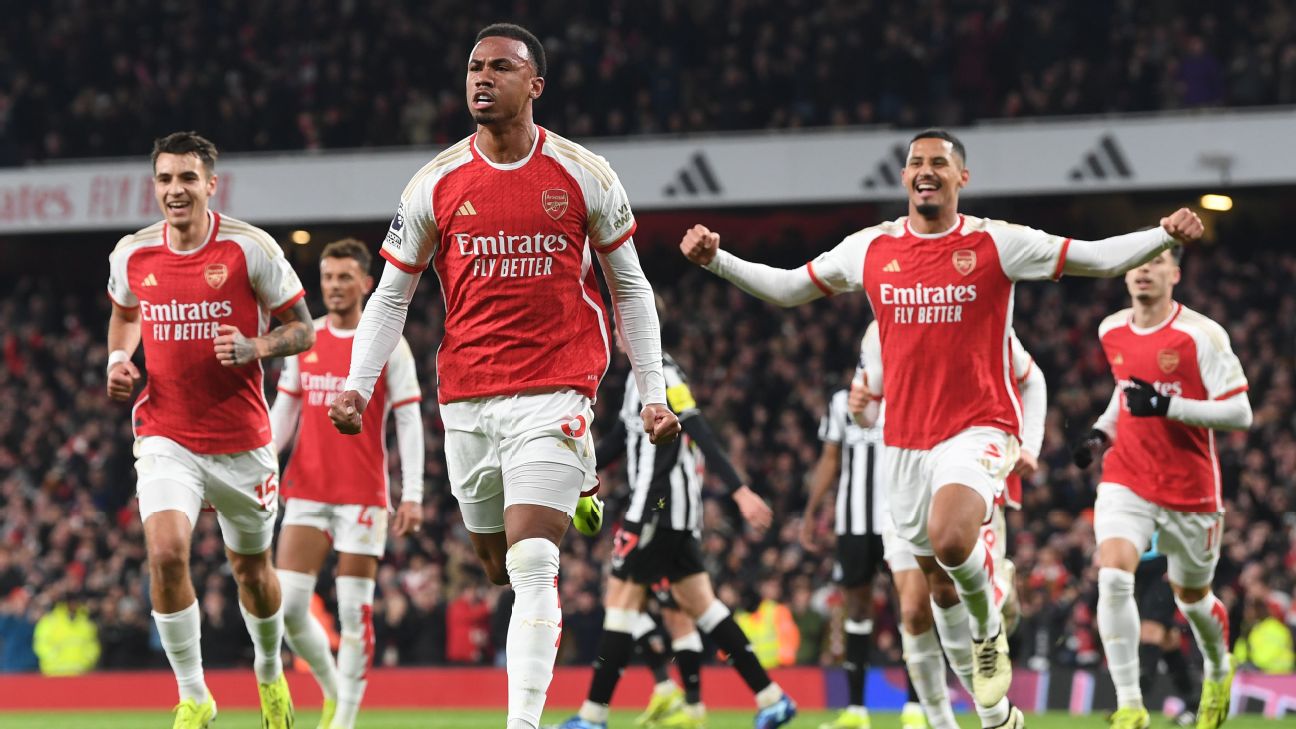Sure, there’s a historically exciting title race going on in the Premier League, but where else can you also get analysis about the race for, I don’t know, seventh or the race for 16th place?
Nowhere — except from Bill Connelly and Ryan O’Hanlon’s recurring Premier League power rankings. Throughout the season, they’ve been updating their opinions of all 20 teams in England’s top division and tracking the progress from one edition to the next. As we enter the home stretch of the final eight matches, ESPN’s two statistical analysis gurus are back to set the stage for what should be an electric final few months.
Once again, they have each ranked all 20 Premier League sides, one through 20, and then combined their rankings to produce one master ranking. The criteria: who we think would win a match if any of these teams played each other on a neutral field in the near future.
The updated rankings are below, followed by some analysis of the most notable changes (or non-changes) from the previous edition of the rankings.
The updated Premier League team rankings
April and February’s rankings — the combination of Bill and Ryan’s individual rankings — are listed along with the new adjustments, plus each team’s present points totals on the Premier League table and goal differential:
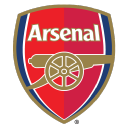 Arsenal: The best team of 2024, for real
Arsenal: The best team of 2024, for real
We may have initially jumped the gun a little bit when we bumped Arsenal up to No. 1 in December’s Premier League rerank. The Gunners responded with an encouraging 1-1 draw against Liverpool but then finished 2023 with a pair of demoralizing defeats to West Ham and Fulham. That dropped them to fourth in the table and sent their title odds plummeting.
Since Jan. 1, however, there is no questioning who the best team in the Premier League has been:
Points per game: Arsenal 2.80, Liverpool 2.55, Manchester City 2.45
Goals per game: Arsenal 3.50, Liverpool 2.82, Newcastle 2.45
Goals allowed per game: Arsenal 0.40, Manchester City 0.73, Liverpool 1.09
Expected goals (xG) differential per game: Arsenal plus-1.73, Liverpool plus-1.51, Manchester City plus-1.22
Arsenal are not only first in all of those primary categories, they’re also first in assists, opponents’ shots per possession and opponents’ xG per shot. They’re dominating possession, giving their opponents absolutely nothing and creating more than enough scoring opportunities for themselves.
Bukayo Saka has seven goals and two assists in this span, while a whopping nine other Arsenal players, from forward Kai Havertz to fullbacks Ben White and Jakub Kiwior, have generated between three and seven goal involvements. Even in Wednesday’s 2-0 win over Luton Town, with a rotated squad, the Gunners dominated the ball while the outcome was in doubt, put the match away with a second goal late in the first half and then basically turned out the lights for the entire second half, attempting only two shots but allowing only three.
This team is very much in control of itself.
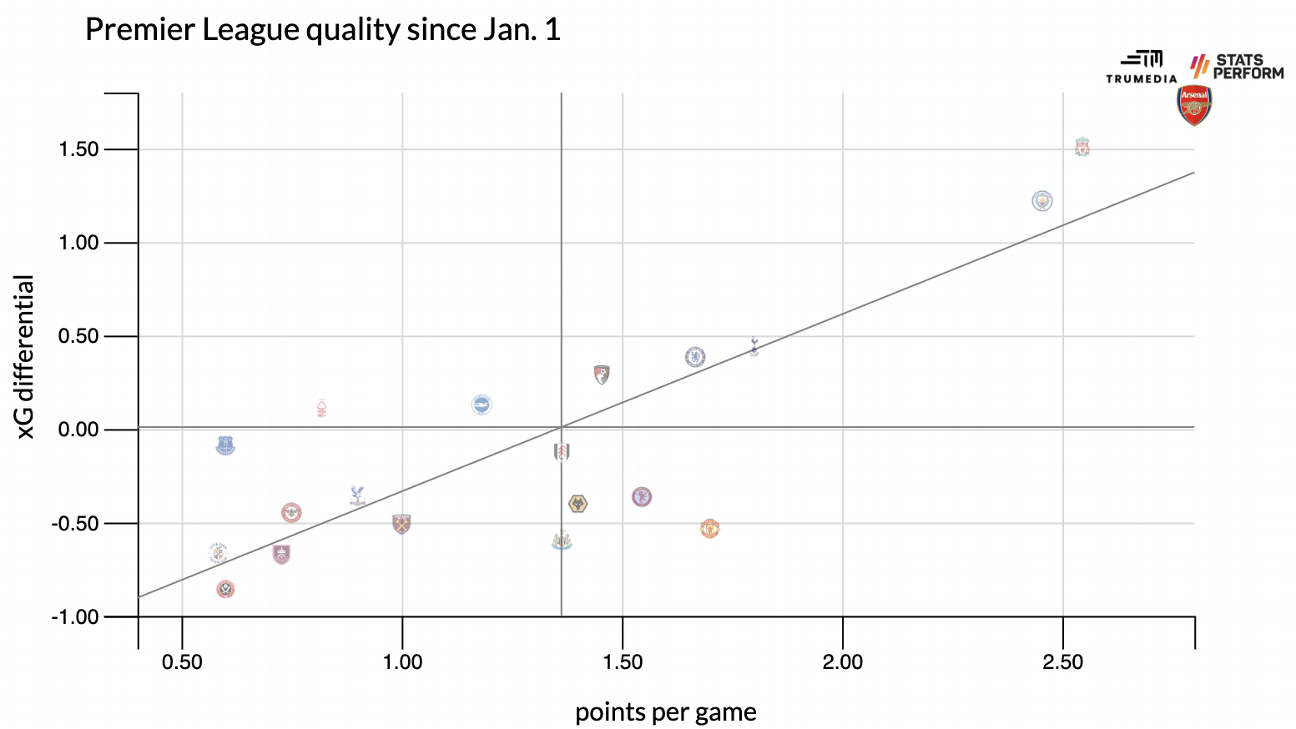
This 2024 run includes not only blowouts of iffy to bad teams (6-0 over West Ham, 5-0 over Burnley, 6-0 over Sheffield United, 4-1 over Newcastle); it also includes a win and a draw against the Premier League’s other two elites. On Feb. 4, they absolutely destroyed Liverpool — the 3-1 scoreline was almost complimentary to Liverpool considering the underlying stats (xG: Arsenal 3.5, Liverpool 0.4). Almost as impressive: they pulled off an old-school, scoreless war-of-attrition draw against Manchester City in Manchester on Sunday.
Granted, Arsenal generated almost nothing for themselves against Manchester City last weekend, completing just 71% of their passes, generating just 28% possession — far lower than the 49% they managed in their 1-0 home win over Pep Guardiola’s squad — and attempting only six shots worth 0.67 xG. But they almost completely erased City’s attack as well: Of City’s 12 shot attempts, only one was worth more than 0.1 xG (a Nathan Aké header saved by David Raya on a corner attempt).

Neither team attempted even 0.1 shots per possession, and the teams combined to put just three of 18 shots on target. Aesthetically, if we’re being kind, we would say that it was an “acquired taste” sort of match: lots of obvious technical skill overrun by an abundance of caution and lots of current or converted center-backs. This wasn’t a glorious performance from Arsenal — far from it — but it wasn’t intended to be. Drawing at the Etihad will always be seen as a great result, especially for an Arsenal team that had lost in its past six league trips to City by a combined 19-3 margin.
It might still turn out to be a costly result, though. A win over City, however unlikely, would have brought Arsenal even with Liverpool on points and, with a superior goal differential, would have given them the league lead. By openly settling for a draw, manager Mikel Arteta was banking on Liverpool slipping up at some point during the season’s home stretch. If the Reds win their final eight league matches, then no matter who the best team is at the moment or what Arsenal do down the stretch, Liverpool will win the Premier League title.
Eight wins is a lot, of course, especially considering how Liverpool have played with their food of late — in their past three matches across all competitions, they’ve lost to Manchester United after holding the lead twice, beaten Brighton after falling behind 1-0 and beaten Sheffield United after allowing a 58th-minute tying goal out of nowhere. Still, a far more flawed Liverpool team won seven straight games late last season, and the Reds unleashed league winning streaks of 10 late in 2021-22 and 18 midway through 2019-20. They’re capable, and according to Opta’s power rankings, their remaining set of opponents is slightly worse than Arsenal’s.
After playing this well for this long a period of time, it would be a missed opportunity for Arsenal not to win its first league title in 20 years. But against two clubs that have raised the bar for sustained quality in the Premier League era — only nine teams have earned at least 92 points in a Premier League season, and six were Liverpool and City teams within the past six years — Arsenal has figured out a way to match them at worst and top them at best. — Connelly
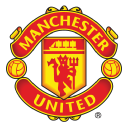 Manchester United: Still stinking up a storm
Manchester United: Still stinking up a storm
The Stats Perform database goes all the way back to the 2008-09 Premier League season. For Manchester United, that means there are 600 league games across nearly 16 full seasons.
Over those 600 games, they’ve allowed their opponent to attempt 25 shots, 10 different times. Four of those games have occurred since Erik ten Hag became the manager last season, and three of them have happened this season.
Over those 600 games, Manchester United have allowed their opponent to take 44 touches or more inside the Manchester United box 18 different times. Twelve of those instances have occurred since Ten Hag became the manager and six of them happened this season. (If you think I’m playing around with end points because of the seemingly random choice to cut it off at 44, they’ve allowed 43 touches in the box and 42 touches in the box, twice apiece, under Ten Hag, too.)
Over those 600 games, they’ve allowed their opponent to generate a non-penalty expected-goal margin of plus-two or more 12 times. Seven of those matches have occurred since Ten Hag became the manager, and four of them have happened so far this season.
Among every Man United manager to coach the team for at least one full season since 2009, here’s how the team stacks up under Ten Hag, compared to everyone else when it comes to controlling the balance and quality of chances they create and concede:

Ten Hag, too, was supposed to guide United into a new era, one in which they could press and dominate field position like his Ajax teams did. But their field tilt (possession, adjusted for final-third passes only) and their opponent pass completion percentage (a proxy for pressing effectiveness) are both worse than they’ve been under any other United manager:

They’ll probably knock out a couple of unlikely results from now until season’s end because their talent level is just too high, but don’t let it fool you: This is the worst Manchester United team we’ve seen since the Premier League was formed. — O’Hanlon

 Fulham and Bournemouth: Sneaky good
Fulham and Bournemouth: Sneaky good
If we take Bill’s chart from earlier, strip away points, flip it sideways and focus only on non-penalty expected-goal differential, here’s how the Premier League stacks up since Jan. 1:
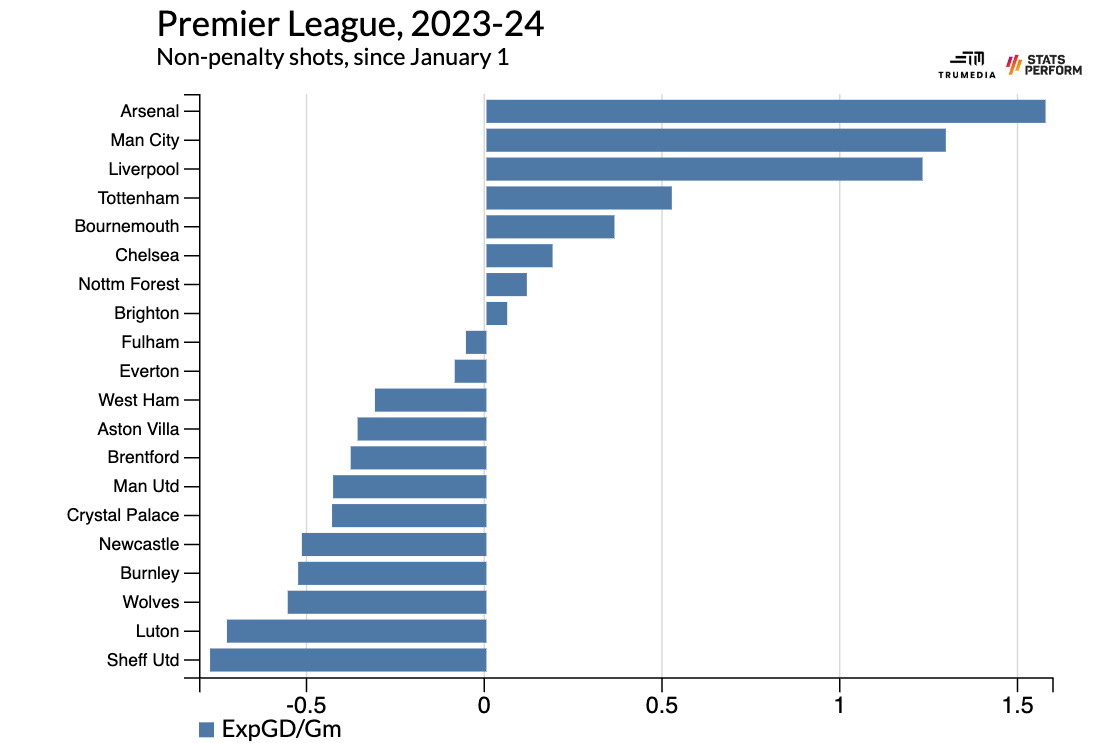
Arsenal? Duh. Liverpool? Uh huh. City? Yep. Tottenham? OK. Bournemouth? Bournemouth?!
While the point totals don’t quite line up with it, Andoni Iraola’s side have been one of the five or so best teams in the league since the turn of the year. We’ve touched on it in past editions of this column, but it’s worth repeating: Bournemouth had the fourth-worst xG differential in the league last season and the second-worst goal differential. That’s likely a big reason why they were willing to move on from manager Gary O’Neil in the offseason, even though they escaped relegation after he took over from Scott Parker.
If we remove the date limitations for this season, Bournemouth still only drop to 11th in non-penalty xG differential. Over the course of the full season, Bournemouth have created slightly more expected goals than they’ve allowed. Despite O’Neil’s success with Wolves this year, Iraola might be the hire of the year — across all of Europe.
There are two specific things that make Iraola’s managerial performance stand out this season. The first is that he’s mostly doing this with the same players who were on the roster last season. Of the 11 most-used players this campaign, just two, winger Justin Kluivert and fullback Milos Kerkez, were acquired this past summer. The biggest personnel change is that Ukrainian center-back Ilya Zabarnyi made three starts last year, and now in his age-20 season, he’s played every minute of every match. He looks like a star in the making.
Not only has the improvement occurred with mostly the same players, but it’s also come through a style that fits the players. Last year, Bournemouth were a typical bad team: little possession, no pressing, long balls, fast movement forward and lots of crossing. This season, they’re controlling more possession and they’re pressing much more aggressively, but they’re actually playing longer passes and crossing the ball more frequently. It’s only one season, but we’ve already seen Iraola do the two things that great managers do: improve his players and impart a distinctive tactical style.
With Fulham, there’s been no managerial change. In fact, the manager lost his best player, center forward Aleksandar Mitrovic, to Saudi Arabia over the summer. Despite that, Marco Silva’s team is better with the ball than they were last year. They’re conceding the same number of xG as they were last season, but they’re scoring more goals per game (1.5 per game, from 1.3) and creating more xG (1.3, from 1.1).
How is that possible? Signed from Everton over the summer, the somehow-still-only-27-year-old Alex Iwobi has given their attack a little more cohesion, connecting the midfield and the forward line. And then Rodrigo Muniz came out of nowhere and started scoring goals for fun.
After scoring two goals while on loan at Middlesbrough in the Championship last season, the 22-year-old Brazilian has a team-leading eight goals for Fulham. But that’s underselling the intensity of his impact. After being in and out of the lineup for the first half of the season, he’s started every match since the beginning of February and all of his goals have come in those nine matches. Here’s every shot from Muniz since February, sized by the xG value of the attempt:
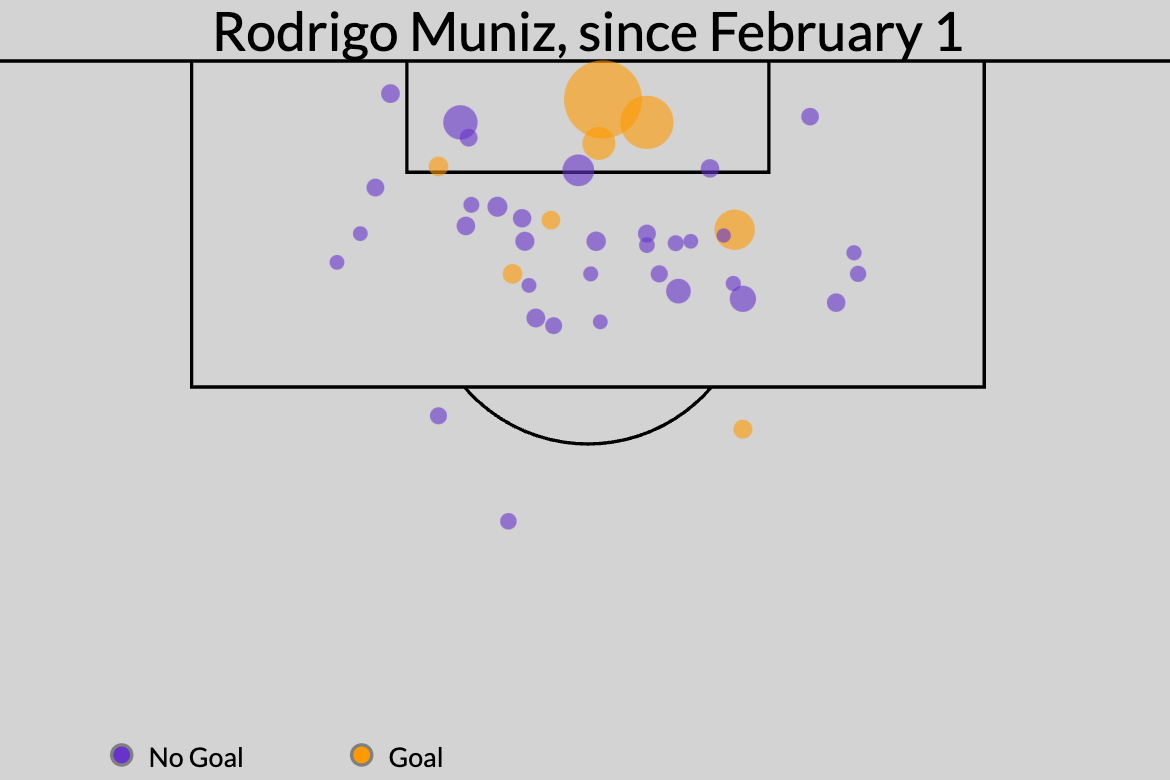
Since the start of February, Muniz is second in the Premier League in non-penalty goals, behind only Phil Foden. While he’s on a bit of a hot streak, it’s all backed up by a quantity and quality of chances, too. He’s attempted three more shots than anyone else in the league over that stretch (45), and only some guy called Erling Haaland has generated more xG with his shots than Muniz’s 5.1.
Although Fulham’s position in the table is behind last year’s pace, they were mostly running off of unsustainable goal-keeping from Bernd Leno and brilliant finishing across their own squad in front of goal. If you told me that would all dry up and they’d lose Mitrovic over the summer, I would’ve told you they were going to be in a relegation fight all year long. Instead, thanks to the additions of Iwobi and Muniz, their luck ran out — and they’ve remained comfortably midtable. — O’Hanlon

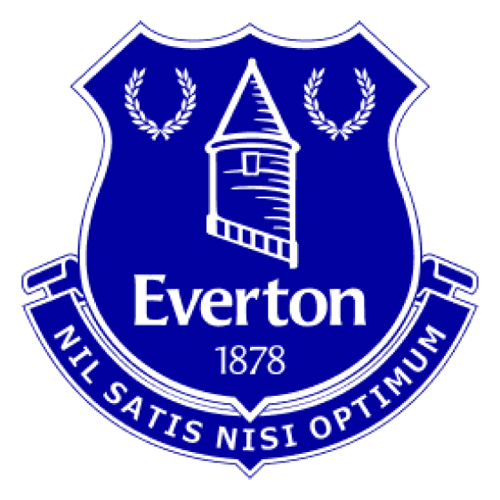 Forest and Everton: Sneaky not terrible
Forest and Everton: Sneaky not terrible
This season’s relegation battle is brought to you by … reckless spending! Without point deductions, only Brentford, an unlucky team with a positive xG differential for the season, would be within even six points of the bottom three heading into the season’s stretch run. The fight would be just about settled already, with this season’s three promoted teams (Luton Town, Burnley and Sheffield United) all preparing to drop back down to the second division.
Thanks to Everton and Forest both dallying with the “Money isn’t real” theory of roster building — hey, it’s worked (kind of) for Barcelona — and receiving six- and four-point deductions, respectively, because of it, we’ve still got a little bit of a battle.
Bottom of the Premier League table:
16. Everton: 26 points
17. Forest: 25 points
18. Luton: 22 points
19. Burnley: 19 points
20. Sheffield United: 15 points
Thanks to positive midweek results — a 3-1 win for Forest over Fulham and a 1-1 draw for Everton at Newcastle — the deduction duo is still above water at the moment. But if you take a gander at Opta’s projections, even this won’t remain a fight much longer. Sheffield United has a 99.4% chance of going down, Burnley’s at 95.8% and Luton Town is at 79.2%, while Forest, despite still having matches against two of the league’s top five teams (Tottenham and Manchester City), is at only 18.8%, Everton 3.6%. The main reason for this discrepancy is simple: Luton, Burnley and Sheffield United are bad, while Everton and, increasingly, Forest are not.
If you wanted to, you could basically break all of soccer down into two components: creating opportunities and converting them. If all that mattered was the former, Everton would be a comfortably midtable team even with the point deductions. They rank 10th in xG created (1.53 per match) and seventh in xG allowed (1.47). Looking specifically at high-quality opportunities, they attempt 2.0 shots per match worth at least 0.3 xG (eighth) and allow just 1.6 such shots (fifth).
We are all well-acquainted with Sean Dyche’s sufferball tendencies at this point — Everton ranks 19th in possession rate (40.3%) and 18th in both pass completion rate (75.5%) and total touches per match (559.2) – but a properly executed counter-attacking game can still succeed in this sport, and Everton has hinted at why and how. Unfortunately, they have been beset by a nearly team-wide finishing funk, turning 1.5 xG into barely 1.0 goals per match.

Dominic Calvert-Lewin — capped 11 times for England in 2020-21 and long regarded as one of the league’s best up-and-coming strikers — has attempted shots worth 10.3 xG this season but has turned that into just four goals, easily the biggest underachievement in the league. His tying penalty against Newcastle on Tuesday was his first goal since October.
Meanwhile, fellow forwards Abdoulaye Doucouré and Beto have scored nine goals from shots worth 12.7 xG, and the sextet of Dwight McNeil, Arnaut Danjuma, James Tarkowski, James Garner, Ben Godfrey and Neal Maupay has turned shots worth 13.2 xG into just five goals. It’s a level of teamwide inaccuracy that you’ll almost never see.
Biggest goals vs. xG underachievement, past 10 Premier League seasons:
1. Everton 2023-24: minus-14.9 goals
2. Fulham 2020-21: minus-14.0
3. Watford 2019-20: minus-13.5
4. Sheffield United 2020-21: minus-13.2
5. Norwich City 2021-22: minus-12.7
6. Chelsea 2022-23: minus-12.1
7. Brighton 2021-22: minus-11.9
8. Everton 2022-23: minus-11.8
9. Burnley 2014-15: minus-11.6
10. Brighton 2020-21: minus-11.6
Everyone else in that top five got relegated. That Everton also made this list last season suggests that this might not all be bad luck — finishing skill is a thing, after all — but if Everton were simply below average at putting decent chances into the net this season, they would be in no danger whatsoever. From the perspective of these power rankings, they belong nowhere near the bottom of the league.
Forest haven’t been nearly as sturdy as Everton in the quality creation department this year, but they’re picking up steam. In their past eight matches, they have attempted 23 shots worth at least 0.3 xG while allowing only 10. Take out Feb. 24’s wild 4-2 loss to prolific Aston Villa, and the margin is 19-5 in the other seven matches. That they only won two matches with two draws in this span was unlikely.
The duo of Morgan Gibbs-White and Anthony Elanga has gone to a new place in this eight-match span. They have combined for eight goals and assists, and if you prefer the nerd stats, their combined expected goals (from shot attempts) and expected assists (from pass completions) is 8.3. They are both in the Premier League’s top 17 in this category.

Forest’s profligate spending has gotten them into trouble.
They have spent over €300 million in transfer fees alone for more than 30 players over the past two years, and many have made little to no impact for the club. But Gibbs-White, added from Wolves two summers ago for €29.5 million, and Elanga, added from Manchester United last summer for €17.5 million, have proved their worth. They’ve combined for 16 goals and eight assists for the season, and if Forest manages to stay up — a prospect still far more likely than not — this duo will be the primary reason why. — Connelly
